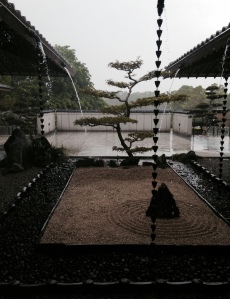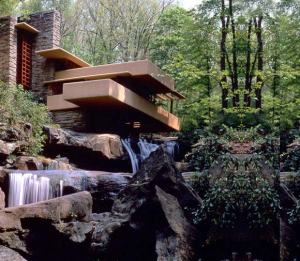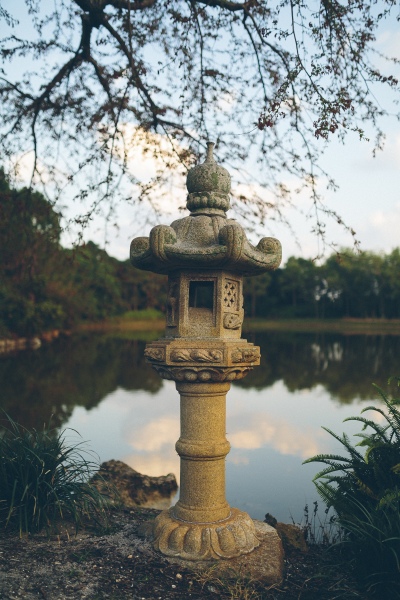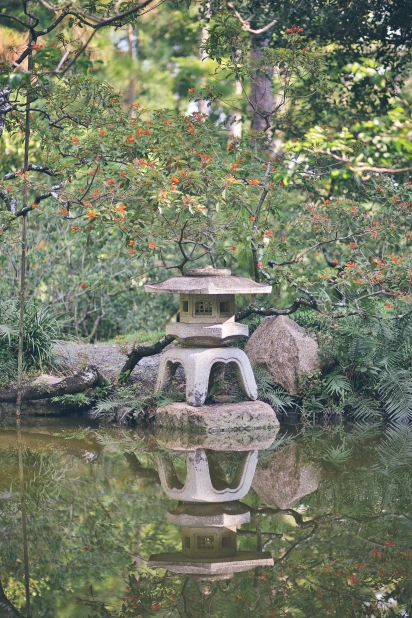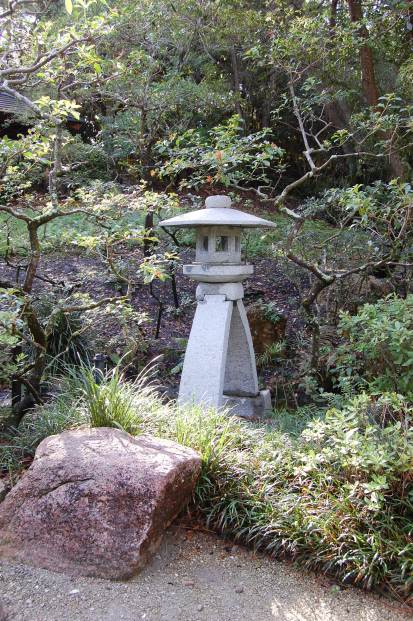Water 水 falls from above, and from below, 水 falls
Four Masterpieces Joined by the Spirit of Water
By Susanna Brooks, Curator of Japanese Art
It is summer, and the rainy season is upon us at Morikami. Rain falls practically every afternoon. The sky becomes dark and the rain falls fast and heavy, culminating into torrential downpours that draw everyone to the windows to take in the stunning, mesmerizing view of water falling from the sky and cascading down the rain chains, nourishing the plants, and dislocating the pebbles in the once-neatly-raked dry garden.
Rain is universally revered for its ability to create and sustain life and respected for the power it has to wound and raze nature when it falls hard and long. This entry provides an abbreviated exploration of the element of water as a meaningful motif in Japanese philosophy and art, primarily as the main subject of two famous 19th-century woodblock prints, which, in turn, share an affinity with two 19th-century Western masterpieces.
Water sustains all life, made evident by the fact that both the Earth and human body are composed of 70 percent water. For many cultures water holds spiritual symbolic meaning, with the natural attributes of water – its flexibility and adaption to change and transformation – equated to ideal human emotions and actions.
A precept of Japanese Buddhism holds water (水 sui, or mizu) second in importance to Earth in the cycle of the five elements of the universe (Earth, Water, Fire, Wind, and Nothingness). Representations of these five elements are present time and again in the design of Japanese architecture, stone lanterns, Buddhist temples and Zen-inspired gardens. In Shintō, the native religion of Japan, water is venerated and presided over by Susano-o, god of the sea and storms, Kuraokami (literally, “dark dragon, tutelary of water”), god of rain and snow, and Suijin, the benevolent deity of water itself. A goal of spiritual practice within Shintō is to become like the flow of water, blurring divisions and transcending boundaries. For that reason, many devotees practice purification rituals under waterfalls (taki shugyō).
As a meaningful element in Japanese art and architecture, water is a leitmotif of many Japanese woodblock prints. Katsushika Hokusai, the artist of The Great Wave off Kanagawa, one of the most recognized images in the world, believed that water was sacred and had the power to purify and restore life in accordance with the natural flow of divine awareness. To Hokusai, water represented the flowing of formlessness in the universe.
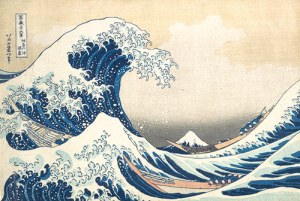
Katsushika Hokusai (ca. 1760 – 1849)
Thirty-Six Views of Mount Fuji: The Great Wave off of Kanagawa
Woodblock print; ink and colors on paper
Edo Period, ca. 1829 – 1832
Photo courtesy of the Metropolitan Museum of Art
Hokusai and his Thirty-Six Views of Mount Fuji inspired the great, woodblock print artist Utagawa (Andō) Hiroshige. Hiroshige was a plein aire artist who strived to depict nature faithfully. He sketched his landscape scenes out-of-doors and then had the images transferred to woodblocks. Here, he captures a group of travelers caught in a rain storm. Hiroshige recorded this scene while traveling with an official delegation through Ise Province in Mie Prefecture.

Utagawa (Andō) Hiroshige (1797 – 1858)
Fifty-Three Stations of the Tōkaidō: Shōno-juku
Woodblock print, ink and color on paper
Edo Period, 1833 – 1834
Gift of Brigitte and Joseph Lonner
1998.065.001
The image is part of the Fifty-Three Stations of the Tōkaidō, a series of prints commemorating the Eastern Sea route from Edo (present-day Tokyo) to Kyoto. Considered Hiroshige’s most famous series, the Fifty-Three Stations was a pivotal watershed in ukiyo-e, for it greatly advanced the landscape as a key subject of this popular woodblock print genre. [1]
Hiroshige traveled the Tōkaidō in 1832 as part of an official delegation that was transporting horses, a gift from the Shogun to the Emperor as a symbol of his loyalty and as a way to pay his respects to the divine ruler of Japan. The landscape so impressed Hiroshige that he captured the journey in a series of sketches. When it was completed, the Fifty-Three Stations of the Tōkaidō numbered fifty-five, with the extra two commemorating the start and end points. Shōno-juku is the forty-fifth of the Fifty-Three Stations of the Tōkaidō.
Just as Hiroshige is celebrated for his rural landscape scenes, so French Impressionist Gustave Caillebotte is best-known for capturing the daily nuances of life on the streets of Paris. In this larger than life-size scene, Paris Street; Rainy Day, Caillebotte brings us practically face to face with a fashionable flâneur (French man of leisure) and his lady strolling in the rain.[2] With its cropped, zoomed-in angles, sharp tilted ground, and flat color palette, Rainy Day has a grand photo-realistic presence and a sensibility reminiscent of 19th-century Japanese prints, which had become all the rage among the French Impressionists. Like Hiroshige, Caillbotte captured a precise moment in time. As the painting’s simple, straightforward title suggests, Rainy Day takes rain as its main subject and creates around it a snapshot of daily life, turning an otherwise ordinary scene into a timeless, monumental work of art.
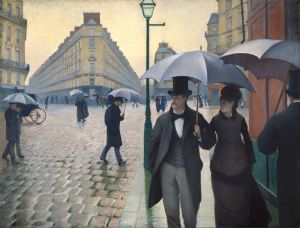
Gustave Caillebotte (1848 – 1894)
Paris Street, Rainy Day
1877
Oil on canvas
Photo courtesy of the Art Institute of Chicago
Another timeless and iconic work of art that takes water as its theme is Fallingwater, one of the greatest architectural achievements of the 20th century. Designed in 1935 by American architect Frank Lloyd Wright, Fallingwater is a 2855 square-foot house built out over a 30-foot waterfall. The home has strong Japanese elements, particularly the manner in which the structure blends in with its environment, harmoniously bridging nature and man. As Japanese architect Tadao Ando has observed, “…Wright learned the most important aspect of architecture, the treatment of space, from Japanese architecture. When I visited Fallingwater in Pennsylvania, I found that same sensibility of space. But there was the additional sound of nature that appealed to me.”[3] The “sound” that Ando referred to was the melodious song of falling water for which the house is named.
Of the 400 structures that Wright built in his lifetime, Fallingwater is considered his greatest masterpiece. The house embraces the essence of Wright’s aesthetic design philosophy, a concept he originated and called organic architecture, which espoused the construction of structures that were in harmony with humanity and the environment. Wright was also a prolific, and for a time, successful, dealer of ukiyo-e, such as those that Hokusai and Hiroshige made and Caillebotte collected.
As water is connected to humanity and the environment, so Frank Lloyd Wright is connected to Japan and Japanese woodblock prints. When Wright first traveled to Japan in 1905, he purchased hundreds of ukiyo-e, including Hokusai’s Thirty-Six Views of Mount Fuji and Hiroshige’s Fifty-Three Stations of the Tōkaidō. The following year, he assisted the curators of the Art Institute of Chicago, where Caillebotte’s Rainy Day is prominently displayed, in organizing a retrospective exhibition of the work of Hiroshige, which featured all fifty-five of the Fifty-Three Stations of the Tōkaidō. Perhaps the correlation between all four of these artists and their masterpieces is merely coincidental, but I like to think that the spirit of water, in all its glorious forms, serendipitously linked their flow.
[1] Ukiyo-e, or “pictures of the Floating World,” describes a genre of woodblock prints and paintings that depicted scenes from everyday life in and around the merchant’s quarters of Edo, primarily the districts they created for pleasure and entertainment. Themes of ukiyo-e include beautiful women (geisha and courtesans), kabuki theater, sumo, historical scenes, and landscapes. The term ukiyo is associated with the Buddhist concept of impermanence and the sorrows (uki) of life (yo), a notion that underscores the temporariness of life, youth, and human desire and pleasure.
[2] Rainy Day is a stately painting that measures 83.5” x 108.7” (approximately 6.9’ W x 9’ H).
[3] Tadao Ando, 1995 Laureate: Biography. The Hyatt Foundation. 1995.
